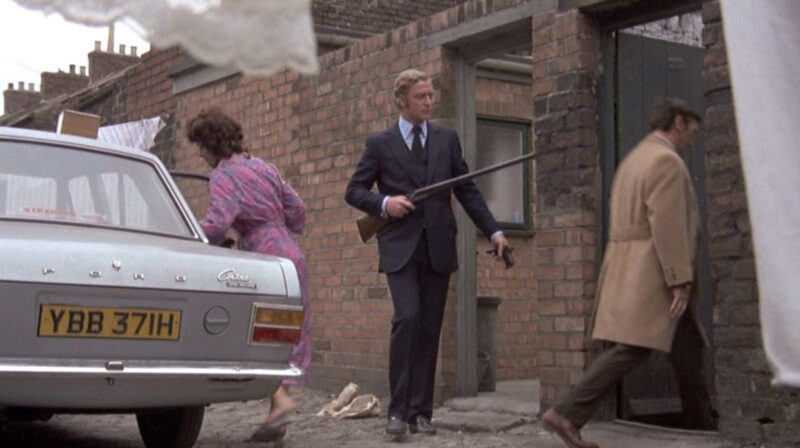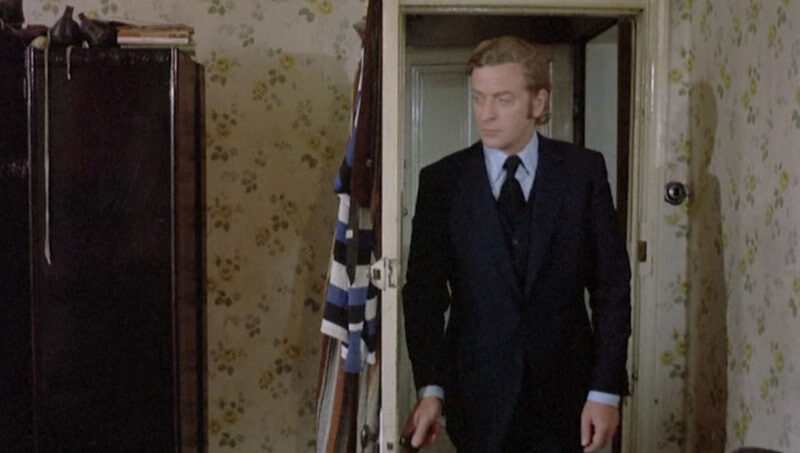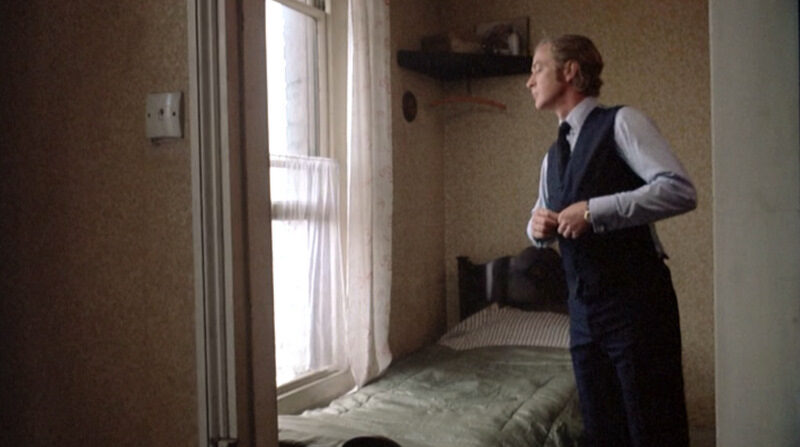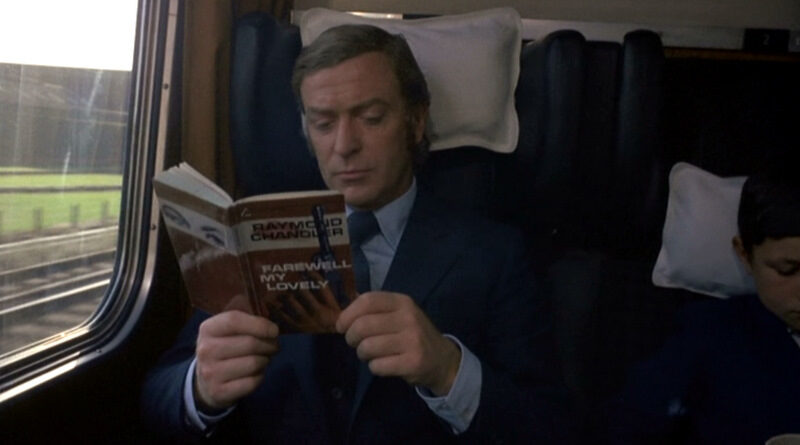Michael Caine in Get Carter: Killer Suit | Clothes on Film
© 2011, Clothes on Film 
22 Jul ’11 Filed under Clothes from 1970s, Guys in Films. Tagged 3 pc, 3 piece, belt, cotton, cufflinks, D ring, Dormeuil, double cuff, Doug Hayward, epaulettes, Evangeline Harrison, flares, gabardine, gangster, Geraldine Moffat, Get Carter, Jack Carter, jacket, James Bond, James Cagney, John Hodges, loafers, mac, Mackintosh, Michael Caine, midnight blue, mini-dress, misogynist, mohair, Petra Markham, polyester, PVC, Roger Moore, Rolex, shirt, single breasted, suit, Tielocken, tonik, trench coat, Turnbull & Asser. Bookmark the permalink. Post a comment. Leave a Trackback (URL).
Cool, coordinated, just a little loud; this is the timeless appeal of Jack Carter’s 3 piece suit. In portraying cinema’s ultimate anti-hero, Michael Caine wears his costume like a second skin.
Get Carter was shot mainly on location in Newcastle for just £750,000. By no means a tremendous success on its release (in the U.S. Get Carter was a double feature with a Frank Sinatra movie), it has since acquired cult status and is now widely recognised as one of the greatest British films ever made. Much has been written about the ‘style’ of Carter; photo shoots of models in trench coats carrying shotguns, etc, yet there has been little appreciation for the fine detail of its central costume itself, a dark blue mohair suit, and what it says about the man who wears it so triumphantly.
Director of Get Carter, John Hodges, admits he personally paid little attention to costume. This would all change one year later for his reunion with Michael Caine in little seen comedy thriller Pulp when Hodges enforced a meticulously brown colour palette throughout. However, for Get Carter this was something he left completely in the hands of costume designer, Evangeline Harrison (Buster, I’ll Sleep When I’m Dead).
Harrison kept things simple; clothes dictated by their environment rather than trends. This is Newcastle 1971, a period when the North of England had yet to undergo regeneration. While London had enjoyed the Swinging Sixties and moved onto the hippy era, Newcastle was still in the midst of skinny ties and scandalous mini-dresses. When Carter arrives he steps back in time. The only costume point of reference he shares with the local inhabitants is a trench coat, except his collar is turned sharply upwards. Similar to a teenager modifying their school uniform, Carter’s every sartorial rebellion is two fingers up; in this instance to a long obliterated past.
By the mid-1970s, the suit itself would die out almost entirely until revitalised by Daniel Hechter and Giorgio Armani in the 1980s. Jackets or blazers and slacks were more popular in new fibres such as textured polyester. The styling points for men became fussier with details such as rear yokes and curved pockets appearing on jackets and wider, tighter flares on trousers. By 1976, Levi would be the biggest selling clothing manufacturer in the world. The look was less formal, more individual. In the meantime though, an exceptionally well cut 3 piece suit could still speak volumes.
Caine’s main ensemble was almost certainly made by Mayfair tailor Douglas Hayward, judging by the actor’s patronage at the time and the style of the suit itself. Haywood was responsible for putting Roger Moore’s James Bond back in a 3 piece in For Your Eyes Only (1981). If there is one indisputable skill Doug Hayward possessed as a tailor, it was his ability to ensure that a suit was flawlessly cut for its wearer. This is nowhere more evident than on Michael Caine in Get Carter. When Carter slips on the heavy, rather taut jacket for his brother Frank’s funeral it practically slots into place:
Midnight blue single breasted, 2 button, 3 piece suit in Dormeuil tonik mohair; jacket long with double vents, slanted pockets, high notched lapel that peaks up; gently flared or ‘boot cut’ single pleat trousers; matching high buttoning waistcoat; jacket and rear of waistcoat backed in baby blue satin viscose; sky blue long sleeved shirt, fitted, high and deep collar with double cuff (also single); worn with large gold and white enamel cufflinks; dark blue silk with diagonal rib four-in-hand necktie (also black woven silk); black calfskin loafers, slight heel with raised tongue and gold ‘snaffle’; Rolex Oyster ‘Datejust’ perpetual wristwatch, gold on brown leather strap.
Dormeuil tonik mohair was popular during the late 1950s and throughout the 60’s, in particular with the Mod crowd. Dormeuil (House of Dormeuil) actually coined the term ‘tonik’ in 1958. They sold this luxury cloth in an astonishing 20 oz per square yard weight, though 9.5 oz (practically summer weight) is far more common today. Mohair is taken from the underside of the Angora goat. Somewhat coarse yet with a detectable sheen, mohair can be troublesome to tailor due to a high level of memory retention that makes it difficult to shape. The advantages of this extravagance are clear, as Carter would know only too well as he selected the suit from his wardrobe. Not just as a staple and serviceable (we presume it is the only suit he packs by his minimal luggage), but also to imply how far he has come – literally and figuratively.
Although restrained for the early 70′s, Carter’s jacket (or ‘coat’ if we talking strict rules of Savile Row) does feature an ostentatious notch lapel that peaks ever so slightly, otherwise known as a ‘Capone lapel’ in the U.S. Evidently a throwback to sartorial embellishments favoured by real life gangsters and their onscreen counterparts, this is a subtle way for Carter to draw attention to his criminal standing. Yet, compared to the opening scene with his gangland bosses, Gerald and Sid Fletcher (Terrance Rigby and John Bindon), one of whom chooses a flamboyant lilac shirt, he is holding back on the archetypal ‘rules of display’ for those of his kind.
Jack Carter wants you to know he has arrived but he does not want to shout about it. Even in the first scene, his only other complete costume change in the story, dressed in a grey flannel, 6-on-2 double breasted suit with single front trouser pleats, he blends rather than offends. Compare Carter to bohemian hoodlum Peter (Tony Beckley) dispatched to Newcastle in a brown leather trench coat with silk neck scarf, and the difference between the two men becomes mirrored by their clothing; calculated versus erratic.
While Carter is not loud with clothing, his accessories are a different matter. Those huge gold cufflinks, white enamel encircled by tiny brown dots, gold buckle loafers, plus a tendency to throw cash at every problem that cannot be solved with violence, are indicative of his personality. Wealth should be exploited at just the right moment. At no point does Carter look more dominant than when towering over his niece/daughter Doreen (Petra Markham), wad of notes in hand and giant cufflinks bobbing in front of her face. He has returned to his roots as king. The high collar on Caine’s not insignificant neck means his face is illuminated in dark shadows; his body blending into the background.
Two different shirts are worn by Caine during Get Carter (not including the pre-credits scene), though the first is hardly perceptible as it is only seen up until the morning of Jack’s brother’s funeral. Judging by the cuff, of which Carter leaves one of the three buttons undone, it is a Turnbull & Asser shirt, likely cotton poplin, as with the double or ‘French’ cuff worn for the rest of the film. There is no apparent justification for the change in style, other than travelling by train in double cuffs with copious cufflinks may have proved cumbersome.
Carter also wears a black trench coat, notably when he arrives at the North Eastern pub, the funeral and during the climactic chase across the beach. It is not a Macintosh, this being a brand name and now generic term for waterproof outerwear. The trench coat was first seen during the prolonged Second Anglo-Boer War (circa 1899), but known then as a Tielocken. Carter’s coat replicates many features that were added by Thomas Burberry’s commissioned version, for example the ‘D’ ring clips on the belt (to hang grenades), throat latch and epaulettes. Typically trench coats are made from gabardine, though Carter’s appears to be cotton, two layers with a thin layer of rubber in the centre. Judging by the distinctive blue check lining, it could have been manufactured by Burberry.
Subverting the filmic tradition that a gangster is characterised by his/her clothes, Jack Carter is at his most dangerous without them. Strolling outside his landlady’s house with a shotgun in hand and nothing else, he is genuinely on the verge of losing control. This is further amplified as he stumbles upon the pornography film featuring Doreen dressed as a schoolgirl, drugged and sexually abused by his recent sexual conquest Glenda (Geraldine Moffat). When Carter hauls Glenda from her bath, his unbuttoned shirt patchy wet and clinging to his skin, he could go either way. If Carter were not so calculating, cogs whirring as to how he might need Glenda still, she probably would have been tossed from the building, just as co-conspirator Cliff Brumby (Bryan Mosley) is moments later.
However, as a symbol of cold viciousness Carter is at his most commanding in that mohair suit. He is defined as a sartorial icon by those around him. During the nightclub scene when he chases Thorpe (Bernard Hepton) into a crowd of inebriated, sideburn sporting youths and girls dancing around their handbags, he stands head and shoulders, literally on occasions, above a sea of polyester trousers and nylon shirts. Likewise in the pub following Frank’s funeral, sitting among tatty sack suits and grubby tweeds, he is a refined, inescapable presence.
Conversely, women in Get Carter are often shot from unflattering angles, disposable as sex objects in mismatched underwear. Misogynist to a degree, but also realistic; representative of a time and environment not yet interested in women as individuals, only as wives, mothers and mistresses.
Carter treats both sexes the same: appallingly. He will use anyone; hurt anyone, even his own flesh and blood, despite negligible adherence to the sentimental gangster ‘code’ (protect thy family honour). Jack Carter may be long gone, but like the stunning blue suit that they no doubt buried him in, his myth cannot be forgotten.
With thanks to David Reeves of David Reeves Bespoke for his assistance with the suit tailoring notes.
You can watch Michael Caine in Get Carter at LOVEFiLM.com.
© 2011, Chris Laverty.
Related Posts:















